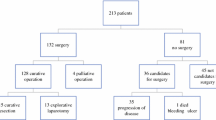PURPOSE: This study was designed to examine the outcome of cancer of the lower rectum, particularly the rates of local recurrence and survival for tumors located in this area that have been treated by anterior or abdominoperineal resections. METHODS: A prospective, observational, national, cohort study which is part of the Norwegian Rectal Cancer Project. The present cohort includes all patients undergoing total mesorectal excision in 47 hospitals during the period November 1993 to December 1999. A total of 2,136 patients with rectal cancer within 12 cm of the anal verge were analyzed; there were 1,315 (62 percent) anterior resections and 821 (38 percent) abdominoperineal resections. The lower edge of the tumor was located 0 to 5 cm from the anal verge in 791 patients, 6 to 8 cm in 558 patients, and 9 to 12 cm in 787 patients. According to the TNM classification, there were 33 percent Stage I, 35 percent Stage II, and 32 percent Stage III. RESULTS: Univariate analyses: The five-year local recurrence rate was 15 percent in the lower level, 13 percent in the intermediate level, and 9 percent in the upper level (P = 0.014). It was 10 percent local recurrence after anterior resection and 15 percent after abdominoperineal resection (P = 0.008). The five-year survival rate was 59 percent in the lower level, 62 percent in the intermediate level, and 69 percent in the upper level (P < 0.001), respectively, and it was 68 percent in the anterior-resection group and 55 percent in the abdominoperineal-resection group (P < 0.001). Multivariate analyses: The level of the tumor influenced the risk of local recurrence (hazard ratio, 1.8; 95 percent confidence interval, 1.1–2.3), but the operative procedure, anterior resection vs. abdominoperineal resection, did not (hazard ratio, 1.2; 95 percent confidence interval, 0.7–1.8). On the contrary, operative procedure influenced survival (hazard ratio, 1.3; 95 percent confidence interval, 1–1.6), but tumor level did not (hazard ratio, 1.1; 95 percent confidence interval, 0.9–1.5). In addition to patient and tumor characteristics (T4 tumors), intraoperative bowel perforation and tumor involvement of the circumferential margin were identified as significant prognostic factors, which were more common in the lower rectum, explaining the inferior prognosis for tumors in this region. CONCLUSIONS: T4 tumors, R1 resections, and/or intraoperative perforation of the tumor or bowel wall are main features of low rectal cancers, causing inferior oncologic outcomes for tumors in this area. If surgery is optimized, preventing intraoperative perforation and involvement of the circumferential resection margin, the prognosis for cancers of the lower rectum seems not to be inherently different from that for tumors at higher levels. In that case, the level of the tumor or the type of resection will not be indicators for selecting patients for radiotherapy.
Similar content being viewed by others
Author information
Authors and Affiliations
Consortia
Corresponding author
About this article
Cite this article
Wibe, A., Syse, A., Andersen, E. et al. Oncological Outcomes After Total Mesorectal Excision for Cure for Cancer of the Lower Rectum: Anterior vs. Abdominoperineal Resection. Dis Colon Rect 47, 48–58 (2004). https://doi.org/10.1007/s10350-003-0012-y
Published:
Issue Date:
DOI: https://doi.org/10.1007/s10350-003-0012-y




